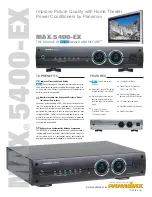
Xtreme Power Conversion Corporation
SPD User’s Manual
Page 8
Power Distribution Unit
User Privileges and Port Reservations
All user levels, including anonymous (visitor), are able to access the system via a serial connection from your work
station to the Local Master port, or via a Telnet session from your work station
Administration Login:
There is 8 Administration account at most on the system. The default name is “admin” and default password is
also “admin”. The default name and password may be changed. If you login at Administration level, you are able to
remove or change existing user accounts, take over power outlets or user serial console ports and change system
settings.
User Login:
At user login level, you are able to reserve power or console ports for your applications if they are “open”, as well
as make system configuration changes. At this login level, you are not able to change power outlet operation status
for other reserved power outlets.
Guest (Visitor) Access:
At user guest level (as an visitor user), you are only able to view the system configuration settings and operate
unreserved power outlets.
Local Master Port Access
To access and configure the system from the master port, you need to connect a RS232 port from your work sta
-
tion to the Local Master Serial Port. Then run a terminal emulation program (such as Window’s Hyper Terminal)
on your computer.
1.
Connect the system’s Local Master Port (DCE) with a straight DB-9 type cable, if your work station is
equipped with a DTE part.
2.
Connect the system’s Ethernet port to your LAN, if you intend to use the network port.
3. Turn the system power on.
4.
At the terminal emulation program, type the “help” for help information.
5.
The system has DHCP enabled, as a default setting. Network connectivity parameters displayed at the
startup screen. If the system does not get a DHCP offer,the system falls back to default static network set
-
tings. You can alter the default network settings to fit your need.
6.
Use the command “ping” to verify your connection. If a network connection is established, you are able to
use Telnet, Web Browsing, Emailing and SNMP.
External Modem Access
With this access method, an RS232 port on an external Modem device is connected to the Local Master Port. Typi
-
cally, a Modem device is equipped with a DCE (Data Communication Equipment) terminal connector. Since the
system’s Local Master Port and Modem device ports are not complementary (both are DCE ports); you need to use
a NULL Modem cable with both male connectors.
Telnet Access
Operation of on a Telnet terminal is almost identical to the access method via Local Master Serial Port. You need
to make sure that Telnet access is enabled, as a default setting. If the access is not enabled, please refer to Section
“Using Configuration Menu” to change the setting.









































